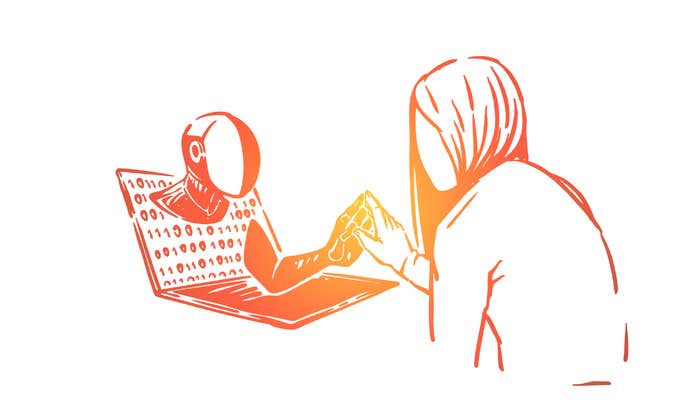Norman Triplett was a pioneer in the psychology of magic, and back in 1900, he published a wonderful scientific paper on magic that, among many other things, discusses an experiment on an intriguing magical illusion. A magician sat at a table in front of a group of schoolchildren and threw a ball up in the air a few times. Before the final throw, his hand secretly went under the table, letting the ball fall onto his lap, after which he proceeded to throw an imaginary ball up in the air.
Described like this, it does not sound like an amazing trick, but what was truly surprising is that more than half of the children claimed to have seen an illusory ball—what Triplett referred to as a “ghost ball”—leave the magician’s hand and disappear somewhere midway between the magician and the ceiling. This was clearly an illusion because on the final throw, no ball had left his hand; the children had perceived an event that never took place.
Triplett carried out several studies using this illusion, and he came to some rather interesting, though not necessarily correct, conclusions. He thought that the illusion resulted from retinal afterimages, or in his own words, “What the audience sees is an image of repetition, which is undoubtedly partly the effect of a residual stimulation in the eye, partly a central excitation.”

At the time, this seemed to be a reasonable suggestion. I came across Triplett’s paper in my early days of researching scientific studies on magic, and I was intrigued by this illusion. Triplett’s Vanishing Ball Illusion relies on a principle that I often used to vanish objects, so I had some ideas as to why the illusion worked. I was skeptical about Triplett’s explanation, and I knew from experience that the illusion relies on misdirecting the audience’s expectations so that they anticipate you throwing the ball for real. A person’s eye gaze provides one of the most powerful tools to misdirect expectations, and so I embarked on one of my first scientific projects to study the role that social cues play in driving this illusion.
I recorded two different versions of the Vanishing Ball Illusion. In the normal version, I threw the ball up in the air twice, before secretly palming it in my hand and simply pretending to throw it up in the air (as shown in the image above). Importantly my gaze followed the ball, and in the pretend throw, my gaze followed the imaginary trajectory of the ball. In a different version of the trick, I carried out exactly the same actions, but this time, my gaze did not follow the imaginary ball. Instead, I stared at the hand that was palming the ball. Triplett’s account of retinal afterimages predicts that both versions of the trick should be equally effective, because both groups of participants observed exactly the same sequence of events and thus had the same sensory stimulation.
Doing science in the 21st century gave me the advantage of new scientific instruments. I could measure participants’ eye movements while they watched video clips of the trick, in order to gain insights into why they experienced the illusion. The findings from this study were surprising: In the normal version of the trick, nearly two-thirds of our adult participants experienced the illusion and claimed that they had seen the magician throw the ball up in the air and that it had left the screen at the top. When I asked them how they thought the trick had been created, these participants typically claimed that someone must have caught the ball at the top or that it had stuck to the ceiling. The illusion does not work for me because I know how it is done; indeed, once you know the secret, it will not work for you either. However, most of the participants in the experiment were fully convinced that they had seen the ball move up and were truly astonished when they watched the video again.
No ball had left his hand; the children had perceived an event that never took place.
My intuition about the role of my gaze was correct, for the illusion was far less effective when I looked at my hand that was concealing the ball. These findings reveal some interesting insights into the illusion. They illustrate that the illusion is mostly driven by expectations, rather than perceptual afterimages. More recently, we have shown that even when you simply pretend to throw a ball up in the air without ever having thrown the ball for real, more than a third of people still experience the illusion. In some ways, we are behaving like dogs who run after the stick their owner simply pretends to throw.
The eye-tracking data revealed some very interesting insights into why the illusion works. After participants watched the video, we asked them about where they were looking, and most of them claimed that they were simply looking at the ball. This, however, was not the case: Although they looked at the ball once it had been thrown in the air, they spent a lot of time looking at my face, particularly before the ball reached the top of the screen. What this shows is that participants used my face to predict where I would throw the ball, which turns out to be a very clever strategy.
We live in a dynamic world where things change rapidly, and we often need to react very quickly. For example, when driving, it is important to anticipate what others are doing so that you can react quickly. One of the main differences between novice drivers and experts lies in their ability to predict what others will do in the future, and eye-tracking studies have shown that as you become more proficient, you start to look farther ahead. I was one of the first people in the world to learn to drive wearing an eye tracker, and this data revealed that the first time I sat behind the wheel, my eyes were pretty much stuck to the hood of the car. However, with experience, I managed to look farther ahead and to use cues in the environment to anticipate future events.
Watching me toss a ball in the air is far less complex than driving, but perceiving a fast-moving ball is much more difficult than one would expect. Seeing a small ball requires us to look at it, but our eyes are bad at tracking fast-moving objects. Seeing the ball requires your eyes to be looking at the right place at the right time, and you have a very short time window to plan an eye movement to the correct location. Looking at the ball is only possible if you can predict where it will be in the future, and this is exactly what our participants did. In other words, they were using my gaze to predict where I would throw the ball.
The eye movement data revealed another interesting finding: Although most of our participants experienced an illusory event, the eyes were not tricked. When the ball was thrown for real, most of the participants managed to look at it when it reached the top of the screen. During the fake throw, participants claimed to have seen the illusory ball at the top of the screen, but they did not move their eyes there, which suggests that our eyes are resilient to the illusion. This result took us by surprise, but it dovetails with several other findings and highlights another truly amazing feature of visual illusions.
The world that you are now perceiving is the world that your visual system has predicted to be the present in the past.
We typically think about vision simply in terms of seeing things, but most of the time, we use our vision without consciously realizing that we do so. For example, as you reach for your cup of coffee, you use visual information to guide your arm movement and adjust your grip so that you can successfully pick up the cup. Back in 1995, David Milner and Melvyn Goodale proposed an influential theory of perception that suggests that the visual processes we require for perceiving objects are driven by separate visual pathways than those involved in visually guided actions, such as picking up an object. Some of the most compelling evidence for this theory comes from a neurological patient who goes by the name “D.F.” D.F. sustained severe damage to the ventral part of her brain, the pathway that is responsible for object perception. She now suffers from a special condition known as agnosia, which means that even though her vision is intact, she fails to recognize objects and simple shapes and can’t even distinguish between horizontal and vertical lines.
One would imagine that not being able to recognize even the simplest of shapes would severely limit her day-to-day capabilities, yet when I met D.F. for the first time, I was astonished by how normal her behavior seemed. She was perfectly capable of navigating a cluttered room, and during lunch, she managed to pick up her knife and fork without problems. How is this possible? D.F.’s lesion has impaired parts of the brain that are responsible for object perception, while the neural systems that are responsible for visually guiding her actions are still intact. As these two systems are anatomically and functionally independent, D.F. is perfectly able to use her vision to guide her actions, while being consciously unaware of the objects around her. For example, even though she is incapable of consciously distinguishing between different line orientations, she is perfectly capable of picking up a letter and putting it in a mailbox.
Picking up objects and interacting with our physical world requires accurate representations of the objects around us, and our perceptual errors imply that we should constantly misjudge our actions. Although my perceptual system is often fooled by illusions, I rarely misjudge where to reach. The reason why I don’t make these mistakes is that the part of the visual system responsible for orchestrating these actions is not fooled by visual illusions. For example, Richard Gregory and colleagues have shown that if participants are presented with a hollow mask and are asked to point to the nose, they point to a location outside the mask. This is because they consciously perceive the face as being solid. However, if you ask them to quickly flick the nose, their hand moves inside the mask and touches the correct location. This is because flicking is a visually guided action that is driven by the dorsal stream, the visual system that requires reliable spatial information, and thus is not fooled by the illusion. Our eyes are also driven by the dorsal stream, so even though your conscious perception has been fooled by the illusion, your eyes have not.
Our visual system has evolved so that we can interact with the world around us, but why are we so easily tricked into seeing an illusory ball? The answer to this question lies in one of the most surprising and possibly unsettling features of our perceptual systems.
The neural delay means we perceive things at least a tenth of a second after they have occurred.
My morning commute takes me through some of London’s busiest transportation hubs, yet I am perfectly capable of navigating my way through the crowds and rarely collide with fellow commuters. One of my other truly astonishing skills involves throwing a ball one meter into the air and catching it. “So what?” you might ask. “Most people can do these things with ease, so why should I be amazed?” These tasks are truly incredible, but a full appreciation requires us to look at the challenges in perceiving our dynamic world.
We see things because objects reflect light that is projected onto our retina, and once our photoreceptors register the light, they send a neural signal down the optic nerve. As we have learned earlier on, perception does not take place in the eyes, and lots of complex neural computations are required before we can experience the world. Neural signals are initiated in the retina and then pass via different neural centers to the visual cortex and higher cortical areas, which eventually build a mental representation of the outside world. Neural processing is not instantaneous because neural signals are passed along neurons at a finite speed. It takes about a tenth of a second for the light registered by the retina to become a visual perception in the brain. This means that our perception lags about a tenth of a second behind what is happening in the world. I will give you a few moments for this thought to settle, and just in case you are still struggling to come to terms with it, let me help you with an analogy: During a thunderstorm, vast amounts of electrical energy are discharged, which results in a flash and a loud bang. As you watch the storm from a distance, you see the lighting before you hear the thunder. This is, of course, because sound travels much slower than light, and so we hear the thunder several seconds after the electrical discharge has occurred. It is the same for perception. The neural delay means that we perceive things at least a tenth of a second after they have occurred.
You might think that a tenth-of-a-second delay makes very little difference to your morning commute, but believe me, this is a substantial delay. Let me put it in context: if you are walking at a modest speed of about one meter per second, a tenth-of-a-second delay will result in you perceiving the world as lagging 10 centimeters behind you. This is quite hard to believe because you simply do not experience the world as lagging, and such a perceptual error should certainly result in many early-morning collisions. Likewise, this perceptual delay should make it impossible for you to catch a ball, especially because this perceptual delay does not account for the substantially longer amount of time your brain requires to plan and initiate a motor response capable of catching the ball.
It is only once you start thinking about some of the huge day-to-day challenges our visual system constantly faces that the true wonders of the brain start to emerge. Our brain uses a really clever and almost science-fictional trick that prevents us from living in the past: we look into the future. Our visual system is continuously predicting the future, and the world that you are now perceiving is the world that your visual system has predicted to be the present in the past. This idea takes a bit of time to get used to, and the first time I heard it, I thought it must be crazy. However, unless we predict the future, we will always experience the past.
Gustav Kuhn is the author of Experiencing the Impossible: The Science of Magic. He is a reader in psychology at Goldsmiths, University of London, and a member of the Magic Circle.
This article was adapted from Experiencing the Impossible: The Science of Magic, published in 2019 by MIT Press.
Lead image credit: ra2studio / shutterstock




























